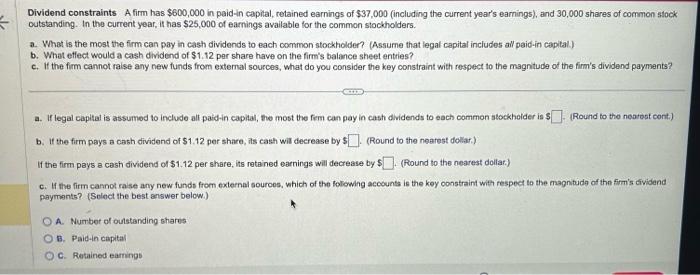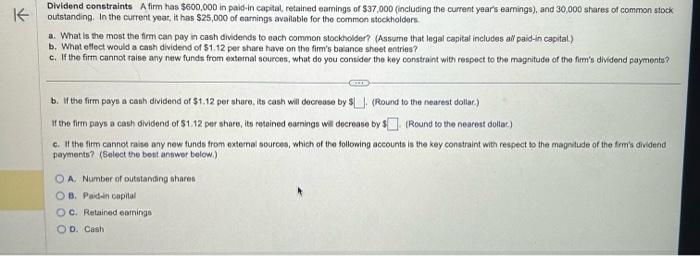Dividend constraints A firm has $600,000 in paid-in capital, retained earnings of $37,000 (including the current year's earnings), and 30,000 shares of common stock outstarving. In the current year, it has $25,000 of eamings available for the common stockholders. a. What is the most the firm can pay in cash dividends to each common stockholder? (Assume that legal capital includes an paid-in capital.) b. What effect would a cash dividend of $1.12 per share have on the firm's balance sheet entries? c. If the firm cannot raise any new funds from extermal sources, what do you consider the key constraint with respect to the magnitude of the firm's dividend payments? a. If legal capital is assumed to include all paid-in capital, the most the fem can pay in catsh dividends to each common alockholder is $ (Round to the nearost cont.] b. If the firm pays a cash dividend of $1.12 per share, its cash wil decrease by $ (Round to the nearest dolliar.) If the firm pays a cash dividend of $1.12 per share, its retained earnings will decrease by 5 . (Found to the nearest dollar.) c. If the firm cannot rase any new funds from external souroos, which of the lollowing accounts is the key oonstraint with respect to the magntuds of the firm's cividend payments? (Select the best answer below.) A. Numbet of outstanding shares B. Paidin capital c. Retained eamings Dividend censtraints A firm has $600,000 in paid-in capital, retained eamings of $37,000 (including the current year's earnings), and 30,000 shares of common stock outstanding. In the current yeat, it has $25,000 of earnings available for the common stockholders. a. What is the most the firm can pay in cash dividends to oach common stockholber? (Assume that legal capital includes ail paid-in capital) b. What elleet would a cash dividend of 51,12 per share have on the firm's balance sheet entries? c. If the firm cannot raise any new funds from extemal sources, what do you consider the key constraint with respect to the magnitude of the firm's dividend payments? b. It the firm pays a canh dividend of $1.12 per share. its cash will decrease by $ (Round to the nearest dollar.) c. If the firm cannot raise any new funds from extemal seurces, which of the following accounts is the key constraint with respect to the magritude of the frm's dividend payments? (Select the best answor telow.) A. Number of outstanding shares B. Paidein capital C. Retained eaminga D. Cash








